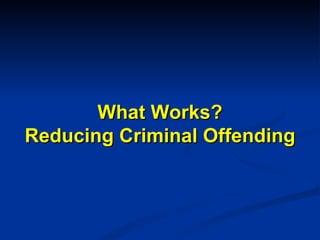Report
Share

Recommended
Development of the SaFETy Score: A Clinical Screening Tool for Predicting Fut...

Development of the SaFETy Score: A Clinical Screening Tool for Predicting Fut...University of Michigan Department of Emergency Medicine
Recommended
Development of the SaFETy Score: A Clinical Screening Tool for Predicting Fut...

Development of the SaFETy Score: A Clinical Screening Tool for Predicting Fut...University of Michigan Department of Emergency Medicine
Keynote: Proven Strategies to Advance Integrated Care in the Latino Community

Keynote: Proven Strategies to Advance Integrated Care in the Latino CommunitySea Mar Community Health Centers
International Journal of Gerontology & Geriatric Research

International Journal of Gerontology & Geriatric ResearchSciRes Literature LLC. | Open Access Journals
Ambulatory Mental Health Visits and Use of Psychotropic Medicines by Cancer S...

Ambulatory Mental Health Visits and Use of Psychotropic Medicines by Cancer S...HMO Research Network
More Related Content
What's hot
Keynote: Proven Strategies to Advance Integrated Care in the Latino Community

Keynote: Proven Strategies to Advance Integrated Care in the Latino CommunitySea Mar Community Health Centers
International Journal of Gerontology & Geriatric Research

International Journal of Gerontology & Geriatric ResearchSciRes Literature LLC. | Open Access Journals
Ambulatory Mental Health Visits and Use of Psychotropic Medicines by Cancer S...

Ambulatory Mental Health Visits and Use of Psychotropic Medicines by Cancer S...HMO Research Network
What's hot (17)
Integrating SMART Recovery into the PA Dept of Corrections

Integrating SMART Recovery into the PA Dept of Corrections
Keynote: Proven Strategies to Advance Integrated Care in the Latino Community

Keynote: Proven Strategies to Advance Integrated Care in the Latino Community
Behavioral Health Care - Issues in Management 2014 Report of Results Final 3 ...

Behavioral Health Care - Issues in Management 2014 Report of Results Final 3 ...
The Power of Choice in Achieving Recovery, by Joe Gerstein, MD, SMART Recovery

The Power of Choice in Achieving Recovery, by Joe Gerstein, MD, SMART Recovery
What Characteristics Differentiate Method Switchers from Discontinuers? 

What Characteristics Differentiate Method Switchers from Discontinuers?
Clinical supervision its influence on client-rated working alliance and clie...

Clinical supervision its influence on client-rated working alliance and clie...
International Journal of Gerontology & Geriatric Research

International Journal of Gerontology & Geriatric Research
Web-based stress management for newly diagnosed cancer patients (MSc Alexandr...

Web-based stress management for newly diagnosed cancer patients (MSc Alexandr...
Ambulatory Mental Health Visits and Use of Psychotropic Medicines by Cancer S...

Ambulatory Mental Health Visits and Use of Psychotropic Medicines by Cancer S...
E centre research - amis dusi-r presentation june 2014

E centre research - amis dusi-r presentation june 2014
Letters from America: refractory psychosis in the us

Letters from America: refractory psychosis in the us
A Preliminary Exploration For The Benefits Of Neurofeedback Ppt[1]![A Preliminary Exploration For The Benefits Of Neurofeedback Ppt[1]](data:image/gif;base64,R0lGODlhAQABAIAAAAAAAP///yH5BAEAAAAALAAAAAABAAEAAAIBRAA7)
![A Preliminary Exploration For The Benefits Of Neurofeedback Ppt[1]](data:image/gif;base64,R0lGODlhAQABAIAAAAAAAP///yH5BAEAAAAALAAAAAABAAEAAAIBRAA7)
A Preliminary Exploration For The Benefits Of Neurofeedback Ppt[1]
Judd Young Poster - Robinson, Herbert, Afari, and Wetherell

Judd Young Poster - Robinson, Herbert, Afari, and Wetherell
Viewers also liked
Viewers also liked (11)
Midwest Conference #2 adolescent sex offenders out

Midwest Conference #2 adolescent sex offenders out
Similar to 2 what works
The effectiveness of a brief stage based intervention, Stacey Bowden and Kati...

The effectiveness of a brief stage based intervention, Stacey Bowden and Kati...NZ Psychological Society
Government Anti-Poverty Programming and Intimate Partner Violence in Ghana

Government Anti-Poverty Programming and Intimate Partner Violence in GhanaUNICEF Office of Research - Innocenti
Similar to 2 what works (20)
The effectiveness of a brief stage based intervention, Stacey Bowden and Kati...

The effectiveness of a brief stage based intervention, Stacey Bowden and Kati...
ArticleSex Offender Recidivism Revisited Review ofRecen.docx

ArticleSex Offender Recidivism Revisited Review ofRecen.docx
ArticleSex Offender Recidivism Revisited Review ofRecen.docx

ArticleSex Offender Recidivism Revisited Review ofRecen.docx
ArticleSex Offender Recidivism Revisited Review ofRecen.docx

ArticleSex Offender Recidivism Revisited Review ofRecen.docx
Supervising the Mental Health Client for APPAinLA2015

Supervising the Mental Health Client for APPAinLA2015
3 Assessment, Classification, and Treatment with Juvenile Delinque.docx

3 Assessment, Classification, and Treatment with Juvenile Delinque.docx
FIN 351 Assignment 3Q1. Core Inc. borrowed a loan of $4,500,00

FIN 351 Assignment 3Q1. Core Inc. borrowed a loan of $4,500,00
Government Anti-Poverty Programming and Intimate Partner Violence in Ghana

Government Anti-Poverty Programming and Intimate Partner Violence in Ghana
More from Anna Salter
More from Anna Salter (17)
6th Annual Jail Conference, Stevens Point, WI Nov 10 – 12th, 2010

6th Annual Jail Conference, Stevens Point, WI Nov 10 – 12th, 2010
TX Forensic Mental Health Conf. #5 Cognitive Self Change

TX Forensic Mental Health Conf. #5 Cognitive Self Change
TX Forensic Mental Health Conf. #2 Fooling Ourselves

TX Forensic Mental Health Conf. #2 Fooling Ourselves
TX Forensic Mental Health Conf. #1. Staff Predators

TX Forensic Mental Health Conf. #1. Staff Predators
2 what works
- 1. What Works? Reducing Criminal Offending
- 14. Impact of Treatment Vs. Sanctions (Andrews, 1998)
- 15. Impact of Treatment Vs. Sanctions Young Offenders Dowden & Andrews, 1999
- 16. Impact of Appropriate Vs. Inappropriate Treatment (Andrews, 1998)
- 17. Type of Treatment Andrew, 1994
- 18. Type of Treatment & Young Offenders Dowden & Andrews, 1999
- 23. Targeting Criminogenic Needs Gendreau, French & Taylor, 2002
- 24. Self Esteem Vs. Criminogenic Needs
- 28. Impact of Cognitive Self-Change Program (Bush, 1995)
- 30. How Many Programs Are Appropriate? (Latessa & Holsinger, 1998)
- 32. ATSA Collaborative Study Recidivism Data Treated N = 5018 Untreated N = 4298 Odds Ratio All programs Sexual 12.3% 17.7% .81 General 28.7% 41.7% .56
- 34. ATSA Collaborative Study Recidivism Data Treated Untreated Odds Ratio Only current programs Sexual 9.9% 17.3% .60 General 32.3% 51.3% .57
- 40. Percent Reconvicted 2-Year Post-release Reconviction Rates in the English Prison Service Hare, Clark, Grann, & Thornton (2000)
